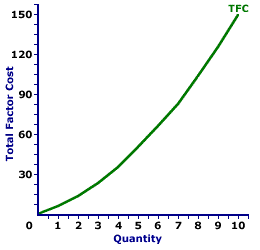
|
|
FOREIGN DIRECT INVESTMENT: The acquisition of controlling interest in foreign firms and businesses from one country in another country. Abbreviated FDI, foreign direct investment can also take the form of constructing factories, structures and equipment (or any form of physical capital) in foreign soil. FDI does not include foreign investment into the stock markets (portfolio investment). Most economists consider foreign direct investment more useful than portfolio investment since this last one is generally regarded as temporal and can leave the foreign country at the first sign of trouble. FDI on the other hand, is considered more durable and with larger economic (potential) benefits.
Visit the GLOSS*arama
|
|


|

|
                           TOTAL FACTOR COST CURVE, MONOPSONY: A curve that graphically represents the relation between total factor cost incurred by a monopsony when using a given factor of production to produce a good or service. The total factor cost curve is most important in factor market analysis for the derivation of the marginal factor cost curve. Monopsony is a market structure with a single buyer or in terms of factor markets, a single employer. This means that monopsony is a price maker, with control over the buying side of the market. Market control means monopsony faces a positively-sloped supply curve. To buy a larger quantity, it must pay a higher price.The total factor cost curve reflects the degree of market control held by a firm. For a perfectly competitive firm with no market control hiring inputs under perfect competition, the total factor cost curve is a straight line that emerges from the origin. For firms with market control, including monopsony, oligopsony, or monopsonistic competition, the total factor cost curve increases at an increasing rate. The shape of the total factor cost curve thus indicates the degree of market control possessed by the factor buyer. Total Factor Cost Curve,
Monopsony |  |
The exhibit to the right displays the total factor cost curve for a hypothetical firm, OmniKing Island Resort. This firm is the only employer of labor on a small tropical island. As the only employer of labor on the island, OmniKing is a monopsony with extensive market control, and it faces a positively-sloped supply curve. To employ more workers, OmniKing must pay a higher price.The vertical axis measures total factor cost and the horizontal axis measures the quantity of input (workers). Although quantity on this particular graph stops at 10 workers, it could go higher. This curve indicates that if OmniKing hires 1 worker (at $6 per worker), then it pays $6 of total factor cost. Alternatively, if it hires 10 workers (at $15 per worker), then it pays $150 of total factor cost. For OmniKing the total factor cost "curve" really is a "curve." The slope of this curve rises as more labor is hired. The changing slope of this curve is due to the changing price. Although this total factor cost curve is based on the employment activity of OmniKing Island Resort, a well-known monopsony firm, it applies to any buyer with market control. Monopsonistic competition and oligopsony firms that also face positively-sloped supply curves generate comparable total factor cost curves.

Recommended Citation:TOTAL FACTOR COST CURVE, MONOPSONY, AmosWEB Encyclonomic WEB*pedia, http://www.AmosWEB.com, AmosWEB LLC, 2000-2024. [Accessed: May 4, 2024].
Check Out These Related Terms... | | | | | | | | | | | | |
Or For A Little Background... | | | | | | | | | | | |
And For Further Study... | | | | | | | | |
Search Again?
Back to the WEB*pedia
|



|

|
BLUE PLACIDOLA
[What's This?]
Today, you are likely to spend a great deal of time at a garage sale trying to buy either a large red and white striped beach towel or a bottle of blackcherry flavored spring water. Be on the lookout for cardboard boxes.
Your Complete Scope
This isn't me! What am I?
|

|
|
Junk bonds are so called because they have a better than 50% chance of default, carrying a Standard & Poor's rating of CC or lower.
|

|
|
"My father used to say to me, „Whenever you get into a jam, whenever you get into a crisis or an emergency . . .become the calmest person in the room and you'll be able to figure your way out of it. " -- Rudolph Giuliani
|

|
CAP
Common Agricultural Policy
|

|
|
Tell us what you think about AmosWEB. Like what you see? Have suggestions for improvements? Let us know. Click the User Feedback link.
User Feedback
|


|


